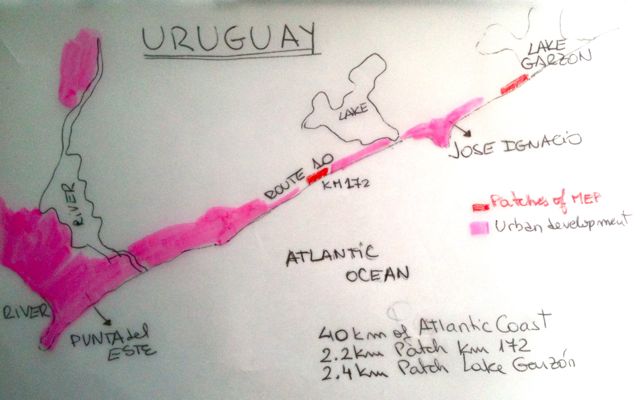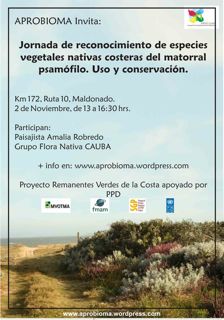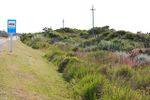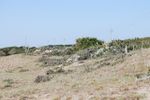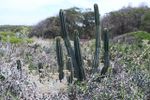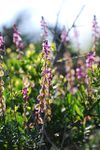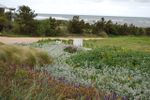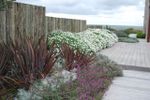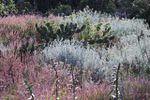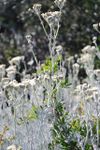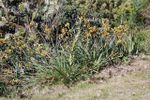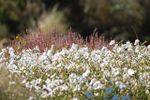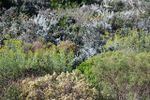Planting Design 2013 Working Group 15 - Case Study D
---> back to group page working group 15
Psamophilic thorny shrubbery
| Name | MEP Matorral Espinoso Psamófilo | |
| Location | Km 172 Route 10 | |
| Country | Uruguay | |
| Authors | Amalia Robredo | |
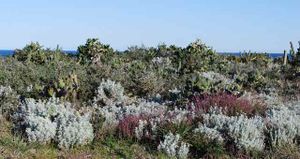
| ||
|
| ||
Rationale: Why is this case interesting?
The MEP (matorral espinoso psamofilo: thorny psamofile shrubbery) is a community in danger of extinction due to urban development. This community is located on the fixed dunes, very close to the sea. It´s location makes it very vulnerable as it is placed just in a very demanded and expensive area for exclusive private homes. There are only a few relicts left and this is one on the km 172 of the Route 10 of Uruguay. Some species are endemic and others represent an important unique genetic resource. All of these plants are the result of the "survival of the fittest" for these particularly difficult exposition to strong salty winds, high temperatures in the summer and sandy soil. As a landscape designer I am often faced to making a garden in plots like this and I find myself with a responsibility for these endangered areas and at the same time I feel I have the opportunity to make a difference.
Author's perspective
I am a professional landscape designer, researcher, plant hunter and University teacher. As a plant hunter and researcher I have specialized on the native grasses and forbes (perennials) of the Atlantic coast of the department of Maldonado in Uruguay, assessing their potential as ornamental, researching on how to reproduce them and at the present I have already introduced a little over 30 native species into my garden designs. The research has always been focused on plant communities and how they relate, as originally the research began on ornamental prairies. My work is alway interdisciplinary with botanist, ecologists and nurseries alike.
Landscape and/or urban context of your case
The Atlantic Coast of Uruguay begins at Punta del Este and follows towards Brazil. The department of Maldonado ends in Lake Garzon where the Department of Rocha begins (up to the border with Brazil). The Atlantic Coast of Maldonado is a very trendy area for Southamericans to spend their holidays and now discovered greatly by Americans and some European tourists from France, Germany, Netherlands and Spain. The urban development has always been along the coastline and the growth of population has been pushing the native plant communities away for good. Even before urban development, forestation with exotic Pines, Eucalyptuses and bushes of Acacia trinervis as curtains for cattle from the Ocean winds, already wiped away most of the Matorral Espinoso Psamófilo and have invaded most of the one left. This community is the result of a very slow ecological succession of stress tolerants and it is formed by a very densely intermingled group of small trees, thorny shrubs, perennials, cactuses, and grasses. They all grow very close and densely in order to protect each other. Their spiny character makes it ideal as refugee for many small vertebrates (reptiles, birds, rodents, etc). The slowness of this succession makes it very difficult to restore from scratch. The perception by the public of this community is not very positive due to its thorny and dense condition, which makes it impenetrable, so at the present there is an effort done towards education of the public so that they can discover its importance and learn to appreciate it in other ways. The change of perception is also based in the beauty of these patches, that have different colours of grays, greens, textures, shapes and even showy flowers in spring! Other things like knowing that the Grindelia orientalis is endemic to this community and that if it disappears then it becomes extinct, or that bees rely on the winter flowers of Baccharis not to die from starvation or that the Eryngium pandanifolium host over 70 insects and small vertebrates (see References)!
- Illustration: Map; sketches; short descriptive analyses
Analytical drawings
There is a strong struggle of forces between nature and urban development. The precise location of these remaining patches of unique plant communities, on a highly valuable and demanded position as beach fronts is the greatest threat, to surrender under urban development. There is very little legislation on what you can and cannot do on these lots.
The greatest change is during spring when most of the perennials flower in bright pinks and daisy like yellows. The rest of the year what catches the eyes are the emerging cactuses, the rounded shapes of the different Baccharis sp. the spades of the Sisyrrinchium palmifolium and the grays and greens of the perennials.
Potentials: - plants that are adapted to the very stressful location (winds, heat, salt and poor in nutrients)
- Gene pool where already the fittest to the site has survived.
- Some plants have very good ornamental features (texture, color and flowers)
Problems: - Perception: people do not instantly "like" them as they are very thorny, specially during the year where there are no flowers that can counteract that effect.
- The plant community is on top of the building site and some damage has to be done in order to build. The challenge is to try to make the less possible damage or to remake a community but with ornamental goals.
- Analytical Drawings
Projective drawings
The project for this specific patch is to preserve it and design transversal paths with signs with info on the community and its characters for education. The patches can also be a source of genetic material for nurseries to produce these plants and made them available for landscape designers.
At the same time I want to deconstruct the community and re build it with an ornamental goal in gardens within the critical area. These plants are the best for surviving in this demanding situation and used in groups or intermingled they can offer a great deal of beauty.
I would like to see in the near future that the patches are preserved and in 10-15 I would like to see that most of the houses on beach fronts use native plants from this communities.
- Projective Drawings
Summary and conclusion
Please summarize your case and give arguments for your projective design (approx 150 words).
Image Gallery
- Image Gallery
References
Google maps.
* I have the copyright of every photo uploaded
Alonso Paz, Eduardo; Bassagoda, María Julia. "Los bosques y los matorrales psamófilos en el litoral platense y atlántico del Uruguay". Comunicaciones Botánicas de Historia Natural de Montevideo, Nro 113, Año 1999, Volumen VI. http://www.guayubira.org.uy/psamofilo/bosquepsamofilo.pdf
Brugnoli, E.; Masciadri, S.; Muniz, P.; Sección Oceanología Facultad de Ciencias. "Base de datos de Especies Exóticas e Invasoras en Uruguay, un Instrumento para la gestión ambiental costera" http://inbuy.fcien.edu.uy/fichas_de_especies/BasedeDatosdeEEIenUruguay-Brugnolietal2009.pdf
Ríos, M; Bartesaghi L; Piñeiro V, Garay A; Mai P, Delfino L, Masciadri S, Alonso-Paz, E; Bassagoda, MJ; y Soutullo A. "Caracterización y distribución espacial del bosque y matorral psamófilo" SNAP- ECOPLATA http://guayubira.org.uy/psamofilo/Psamofilo_Ecoplata_2010.pdf
Robredo, A., Arballo, E. "Herbáceas, Gramíneas y Aves Asociadas de la Costa Atlántica de Maldonado. Descubriendo su valor para el paisajismo". ISBN 978-9974-563-81-0. Junio 2011.
Soutullo A., Alonso E., Arrieta D., Beyhaut R., Carreira S. Clavijo C., Cravino J., Delfino L., Fabiano G., Fagundez C., Haretche F., Marchesi E., Passadore C., Rivas M., Scarabino F., Sosa B., Vidal N. Especies Prioritarias para la Conservación en Uruguay 2009. SNAP. Sistema Fortalecimiento del Proceso de Implementación del Sistema Nacional de Areas Protegidas. Serie de Informes N16.
Vucetich M.C., Rossi J.B. Estudio preliminary de la fauna fitotélmica de Eryngium pandanifolium Cham et Schlecht. Limnobios, Vol. 1, Fasc. 10 (1980).
About categories: You can add more categories with this tag: "", add your categories
